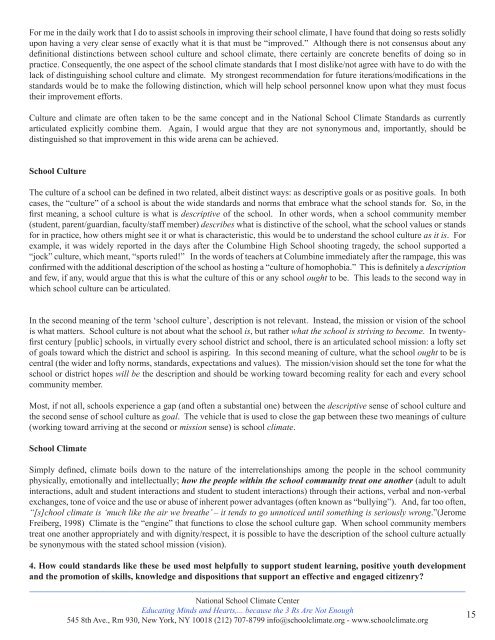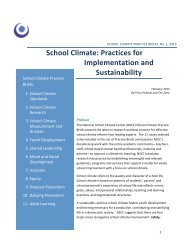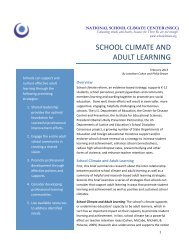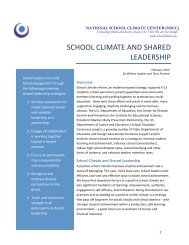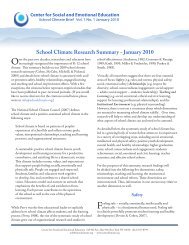Download PDF - National School Climate Center
Download PDF - National School Climate Center
Download PDF - National School Climate Center
You also want an ePaper? Increase the reach of your titles
YUMPU automatically turns print PDFs into web optimized ePapers that Google loves.
For me in the daily work that I do to assist schools in improving their school climate, I have found that doing so rests solidly<br />
upon having a very clear sense of exactly what it is that must be “improved.” Although there is not consensus about any<br />
definitional distinctions between school culture and school climate, there certainly are concrete benefits of doing so in<br />
practice. Consequently, the one aspect of the school climate standards that I most dislike/not agree with have to do with the<br />
lack of distinguishing school culture and climate. My strongest recommendation for future iterations/modifications in the<br />
standards would be to make the following distinction, which will help school personnel know upon what they must focus<br />
their improvement efforts.<br />
Culture and climate are often taken to be the same concept and in the <strong>National</strong> <strong>School</strong> <strong>Climate</strong> Standards as currently<br />
articulated explicitly combine them. Again, I would argue that they are not synonymous and, importantly, should be<br />
distinguished so that improvement in this wide arena can be achieved.<br />
<strong>School</strong> Culture<br />
The culture of a school can be defined in two related, albeit distinct ways: as descriptive goals or as positive goals. In both<br />
cases, the “culture” of a school is about the wide standards and norms that embrace what the school stands for. So, in the<br />
first meaning, a school culture is what is descriptive of the school. In other words, when a school community member<br />
(student, parent/guardian, faculty/staff member) describes what is distinctive of the school, what the school values or stands<br />
for in practice, how others might see it or what is characteristic, this would be to understand the school culture as it is. For<br />
example, it was widely reported in the days after the Columbine High <strong>School</strong> shooting tragedy, the school supported a<br />
“jock” culture, which meant, “sports ruled!” In the words of teachers at Columbine immediately after the rampage, this was<br />
confirmed with the additional description of the school as hosting a “culture of homophobia.” This is definitely a description<br />
and few, if any, would argue that this is what the culture of this or any school ought to be. This leads to the second way in<br />
which school culture can be articulated.<br />
In the second meaning of the term ‘school culture’, description is not relevant. Instead, the mission or vision of the school<br />
is what matters. <strong>School</strong> culture is not about what the school is, but rather what the school is striving to become. In twentyfirst<br />
century [public] schools, in virtually every school district and school, there is an articulated school mission: a lofty set<br />
of goals toward which the district and school is aspiring. In this second meaning of culture, what the school ought to be is<br />
central (the wider and lofty norms, standards, expectations and values). The mission/vision should set the tone for what the<br />
school or district hopes will be the description and should be working toward becoming reality for each and every school<br />
community member.<br />
Most, if not all, schools experience a gap (and often a substantial one) between the descriptive sense of school culture and<br />
the second sense of school culture as goal. The vehicle that is used to close the gap between these two meanings of culture<br />
(working toward arriving at the second or mission sense) is school climate.<br />
<strong>School</strong> <strong>Climate</strong><br />
Simply defined, climate boils down to the nature of the interrelationships among the people in the school community<br />
physically, emotionally and intellectually; how the people within the school community treat one another (adult to adult<br />
interactions, adult and student interactions and student to student interactions) through their actions, verbal and non-verbal<br />
exchanges, tone of voice and the use or abuse of inherent power advantages (often known as “bullying”). And, far too often,<br />
“[s]chool climate is ‘much like the air we breathe’ – it tends to go unnoticed until something is seriously wrong.”(Jerome<br />
Freiberg, 1998) <strong>Climate</strong> is the “engine” that functions to close the school culture gap. When school community members<br />
treat one another appropriately and with dignity/respect, it is possible to have the description of the school culture actually<br />
be synonymous with the stated school mission (vision).<br />
4. How could standards like these be used most helpfully to support student learning, positive youth development<br />
and the promotion of skills, knowledge and dispositions that support an effective and engaged citizenry?<br />
_____________________________________________________________________________<br />
<strong>National</strong> <strong>School</strong> <strong>Climate</strong> <strong>Center</strong><br />
Educating Minds and Hearts,... because the 3 Rs Are Not Enough<br />
545 8th Ave., Rm 930, New York, NY 10018 (212) 707-8799 info@schoolclimate.org - www.schoolclimate.org<br />
15


